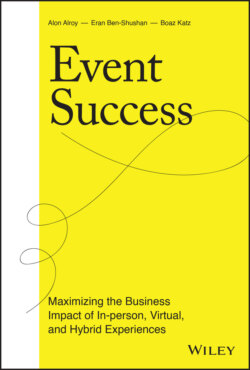Читать книгу Event Success - Alon Alroy - Страница 24
ОглавлениеCHAPTER 5 The Event Data Maturity Curve
From our perspective, the biggest gift the pandemic offered was furthering the events industry along the event data maturity curve, a framework for understanding how the industry has progressed toward maximizing the value of data.
Identifying the Four Steps of Event Data Maturity
Events have long stagnated behind most other industries in the use of data, but they are finally starting to catch up. The first step in the event data maturity curve is improving the availability of data, which is more robust today thanks to holistic tools, event applications, and the digitization of events in general. We call this step data capture. Event organizers can see which sessions an attendee signs up for and which company an attendee represents. Email marketers can see which contacts open their emails and which links they click in those emails (if any). In short, because of the availability of more technologies and their growing sophistication, we now have a lot more data to work with.
The second step in the event data maturity curve for event organizers is to connect that data to business systems—such as customer relationship management (CRM) platforms, the sales technology stack, digital marketing platforms, and association management systems—in order to enrich those systems. We call this step data integration. Insights into attendees and their actions—such as the type of people they interact with, the types of sessions they attend, and how engaged they are in those sessions—will help paint a picture of customer intent.
Intent data is the holy grail of B2B event insights and is traditionally very hard to extract. As Nicola described it, “Understanding when somebody is showing a buying signal from a product they don't own” has tremendous value in aiding sales efforts. As we move further along the data maturity curve, events will emerge as a powerful source of data that can help convert prospects and upsell existing customers.
Part of that same process includes utilizing data to offer better and more valuable attendee experiences. To actually personalize events to the point where 5,000 attendees can have 5,000 unique experiences is still an aspiration more than a reality, but we're finally moving in the right direction.
In order to achieve those attendee experience and business outcome goals, organizers need to master the next step of the event data maturity curve: the ability to identify and curate the precise data points that can help achieve those goals. We call this data utilization. It's one thing to plug your event data into your business management systems; it's another to ensure that it's capturing and analyzing useful data that can enrich those systems. Moving from the first stage of data capture to the stage of data utilization is no small feat, but new tools and platforms will help ease the transition.
The final step in the event data maturity curve is translating those data points into insights. On the attendee side, this data can help you improve the event experience in a number of ways. For instance, if you discover that 40 percent of your attendees are young, early-career professionals, you can tailor the content and agenda accordingly. If you were to gain better insights into why attendees choose your event over your competitors, you can lean into those key features. If you discover that 30 percent of your attendees are traveling to your event in the United States from Asia, it might make sense to host a standalone event that caters to that market specifically.
Improving the attendee experience will ultimately help drive ROE. If you can increase engagement in a measurable way—if you can curate experiences that speak to each attendee—attendees are far more likely to find value in attending and return year after year.
If you were to ask the average person what their best experience was at any event they've attended, the answers might range from meeting the person who changed their career trajectory to a meeting privately with a keynote speaker. Everyone who attends events on a regular basis has a few highlights that stand out above the rest, and they are much more likely to return to the events that facilitated them. If you can drive more of those experiences, if you can find out what gets people most excited and offer it to them on a consistent basis, you can create a loyal and engaged event attendee.
Using Data to Make Events Outcome-Oriented
Improving the event experience goes hand in hand with improving event outcomes. As we move along the maturity curve, outcomes will eventually be designed into the fabric of event experiences from day one. In other words, a specific event will be designed to achieve a specific outcome among a specific group of participants, optimized and measured every step of the way.
Looking a little further off into the future, this data will eventually allow an AI engine to help event experience leaders design events to achieve specific outcomes. We imagine a world where you can plug in your objectives, budget, target audience, and a few other data points and have an automated system recommend the appropriate event size, venue, host city, speakers, activations, and playbooks you can draw on. Just as an AI engine could inform decisions of how to design an event, so could it inform decisions around which accounts, attendees, sponsors, or exhibitors to target and the type of content that will help drive specific outcomes across that group.
This isn't a matter of science fiction, but rather a matter of data maturity, and we're already making significant strides in the right direction. Over time we will have enough data to train an AI system to provide these types of recommendations. It won't be easy, but it's absolutely within the realm of possibility. After all, plenty of other industries are already able to do this effectively, including entertainment (Netflix), e-commerce (Amazon), and social media (Facebook).
